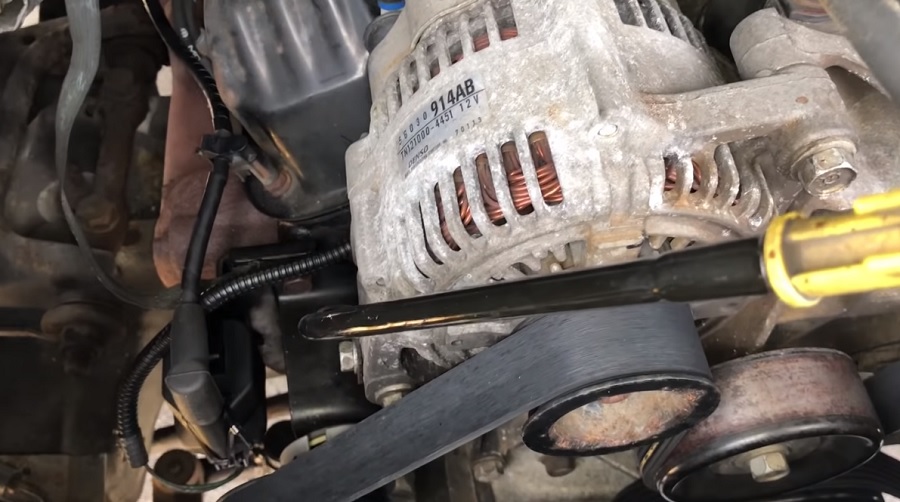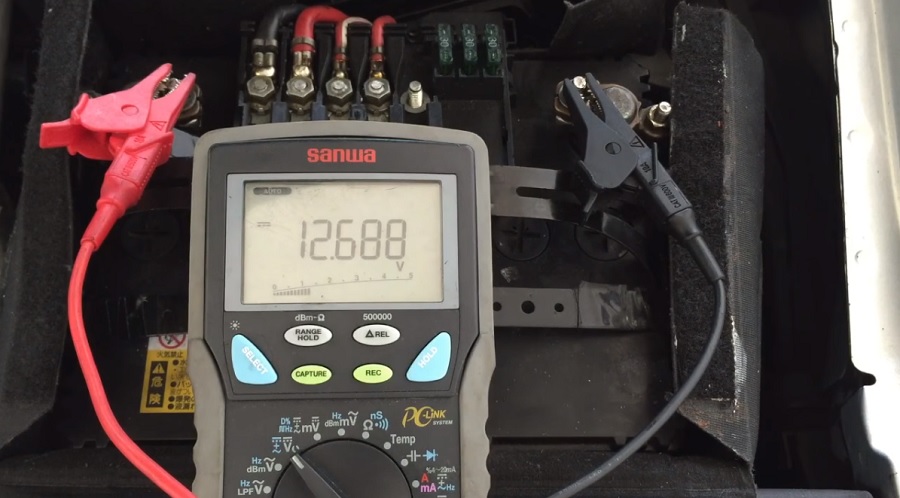In the past, the alternator was mainly used to supply the electricity for the vehicle’s lighting system. Today, the alternator not only has to provide the electricity for the lighting system, but also the electricity for the starter battery and various other electrical equipment. That is why we now speak of a generator rather than an alternator.

The basic principle of an alternator is always the same: part of the rotational energy of the crankshaft is converted into electrical energy. If the generator was not built directly around the crankshaft, the rotational movement of the crankshaft must first be passed on to the alternator. In most cases, this is done using a V-belt or a V-ribbed belt. The most important elements of the alternator are charge controllers, roller bearings, carbon brushes, diodes, freewheels and slip rings.
Alternator tasks
Nowadays the alternator is mostly a three-phase generator. It produces electricity for all electrical consumers in the vehicle while the vehicle is in motion, ventilation and rear window heating being the main customers. But even the engine control unit needs current pulses in order to function. The alternator is also responsible for ensuring that the starter battery is charged or kept fully charged while driving. Because the battery is the energy storage in the car and forms the back-up of the generator, so to speak, sometimes even while driving. If the combustion engine is switched off, the battery discharges – for example if consumers like the parking lights remain switched on or if the parking heater is always used for short journeys.
Alternator performance
Many are familiar with this from old mopeds or Vespas: when the vehicle is idling, the headlights only flare up gently. On the other hand, when you turn the throttle, the light shines brightly. These times have been over since the early 1980s and with the use of the three-phase generator. Modern alternators already provide sufficient power and thus electricity at idle speed (between 650 and 900 revolutions of the crankshaft) to supply consumers in the car.
Compared to the older systems (direct current and alternating current generators), three-phase generators are not only more powerful, but also more reliable, smaller (roughly the size of a handball) and lighter (approx. Nine kilograms) Auto matched existing consumers. It may be a maximum of ten percent lower than the power consumption of all customers in the car if they are activated at the same time. The ten percent difference then bridges the battery in an emergency – the backup mentioned.
Due to the steadily increasing number of electrical consumers in the car, the charging current of the alternators has continued to increase. While around 50 amps of charging current was sufficient for a compact car in the 1980s, alternators today generate between 100 and 250 amps, depending on the vehicle type. Incidentally, not only the comfort functions expanded in modern cars are among the current collectors, but also engine technology such as high-pressure pumps for the fuel supply or the solenoid valves of the injection nozzles.
Function of the alternator
Simply put, the generator converts the mechanical energy of the crankshaft into electrical energy by rotating it inside. The excitation field is brought about by the rotor, which is about the size of a fist, and usually induces three-phase AC voltage, which is fed into the vehicle electrical system after rectification. In most cases, the generator is driven by the V-belt or V-ribbed belt, which is connected to the alternator via a pulley. In addition to generating electricity, the alternator also charges the starter battery while driving. The alternator uses engine power to produce electricity, around five horsepower is possible. That costs fuel and sprinting at the same time. Therefore, modern alternators are demand-controlled to make the energy conversion more efficient. When the vehicle accelerates strongly, the generator power is reduced and the resistance is reduced. In phases of coasting, on the other hand, in which the engine does not consume fuel due to the coasting cut-off, more power is drawn from the alternator, and the resistance increases.
Charge indicator light – first indication of defects

An important “tool” for checking the function of the alternator itself is installed right in front of the driver. This is the charge control light in the instrument cluster. The generator or battery symbol always lights up when the ignition is switched on. If it still lights up when the engine is still running and idling, this could be a sign that the consumers that are switched on are not being supplied with the necessary power and that the battery is currently supporting the system. To clarify this, a short push on the accelerator pedal is enough. Most of the time the light goes out suddenly and everything is good. If the light stays on, it could be a sign that the alternator is defective.
Alternator defective
In principle, three-phase generators are maintenance-free and wear-resistant and often last a lifetime. However, if the alternator is broken, the battery is gradually drained. In the worst case, the engine stops while the vehicle is moving, because the engine control unit and fuel pump still have to be supplied with power. It went better when the driver became skeptical because the car struggled to start in the morning, even though a long distance had been covered the day before. Because in this case the starter battery should actually be fully charged.
What can break in an alternator?
- The carbon brushes of the alternator regulator are worn out.
➤ Symptoms: charge control light is on, battery is not being charged
➤ Solution: replace brushes or regulator - The alternator regulator is defective.
➤ Symptoms: battery gets hot (overcharge), battery weak (no charge), charge control light becomes brighter with increasing speed, light burn through.
➤ Solution: replace alternator regulator. - The bearings of the belt drive or the freewheel are defective.
➤ Symptoms: Noise from the belt drive (whistling, grinding), battery is not charged, charge indicator light is on.
➤ Solution: Check the belt drive and freewheel and replace if necessary. - Corrosion or defects in cable connections.
➤ Symptoms: Charging voltage is not reached, differential voltage between alternator and battery.
➤ Solution: Check / replace cables and connections. - V-belt has too little tension.
➤ Symptoms: Loading control light flickers, V-belt slips and squeaks in the process
➤ Solution: Tension or replace V-belt. - Short circuit or interruption of the diodes.
➤ Symptoms: battery discharged while stationary (if the plus diode is defective).
➤ Solution: disconnect the battery, replace or repair the alternator. - Alternator winding is defective.
➤ Symptoms: Charge indicator light is on, battery is not charging.
➤ Solution: Replace or repair alternator. - Alternator rectifier is defective.
➤ Symptoms: battery does not charge, indicator light on.
➤ Solution: replace or repair alternator.
Check the alternator with a multimeter
If a problem arises, it is relatively easy to test an alternator. The charging voltage of the alternator is checked with a multimeter (available from around $20):
- Set the DC voltage range on the multimeter (up to 15 or 20 V)
- Connect the black terminal to the ground pole, the red terminal to the positive pole
- When the engine is switched off, the voltage of the car battery should be between 12.2 and 13.6 volts (if the voltage is significantly lower, i.e. below 12 volts, charging with a charger is recommended)
- Switch on the engine, the charging voltage should be approximately 13.4 to 14.8 volts at idling speed
- Repeat the measurement at a speed of 4000 rpm, the voltage should remain constant

If the voltage does not rise to the specified values after a few seconds with the engine switched on, this indicates a defect in the alternator. In order to prevent damage to the wiring, the measurement on the contacts of the alternator can be checked. If there is a clear difference, the cabling must be checked! If the voltage at 4000 rpm rises visibly above the value measured during idling, this indicates a defect in the alternator regulator. In this case, the battery can overheat and damage the on-board electronics. In the workshop, the mechanic can also check the alternator with an oscilloscope and interpret the measured value curves accordingly.
Alternator regulator defective
The generator regulator, also called voltage regulator, is integrated in the generator. One of its tasks is to keep the generator voltage approximately constant at all loads and speeds. This is the only way to ensure that there are no voltage fluctuations that could damage electronic components in the vehicle. The controller is designed in such a way that it allows the generator voltage to settle to around 14 volts (alternator charging voltage) so that the voltage is below the gassing voltage of the starter battery.
The two small carbon brushes of the alternator regulator are often worn – recognizable by the fact that the brushes are significantly shorter. In older vehicles, only the carbon brushes can be replaced, the cost is a few euros. If the entire alternator regulator has to be replaced , this costs between 20 and 80 euros. Depending on the accessibility, the installation time is between ten minutes and one hour. However, it can also be complex: If the engine compartments are difficult to access, additional units may have to be dismantled to replace the alternator regulator, making the matter a case for the workshop.
Check the V-belt and belt drive
Also to be checked quickly: the tension of the V-belt and the pulley freewheel. It decouples the alternator belt drive from the vibrating crankshaft that drives the belt. Normally, the generator runs at about twice the speed of the crankshaft, which can mean between 1400 and 12,000 revolutions per minute – maximum performance. It is therefore hardly surprising that the bearings integrated in the pulley do not always withstand such a load in the long run. A grinding and squeaking noise when the engine is switched on, which emanates directly from the free wheel on the alternator, reveals bearing damage. If this is defective, the belt pulley can sometimes be dismantled even with the generator installed and the bearing inside can be replaced (fixed with Torx or multi-tooth). Replacement costs between 20 and 60 euros, depending on the model and quality.










Hi, my name is Son Ho. I’m deaf. My car alternator is broken!. Battery alternator problem. I don’t know how to fix it, my car Toyota Corolla Le 2004 is old.
If your car’s alternator is broken, then you will have to replace it with a new one. Its not feasible to repair the old one.